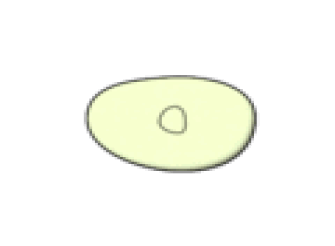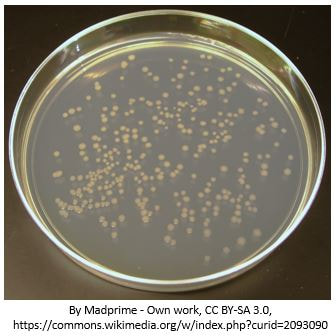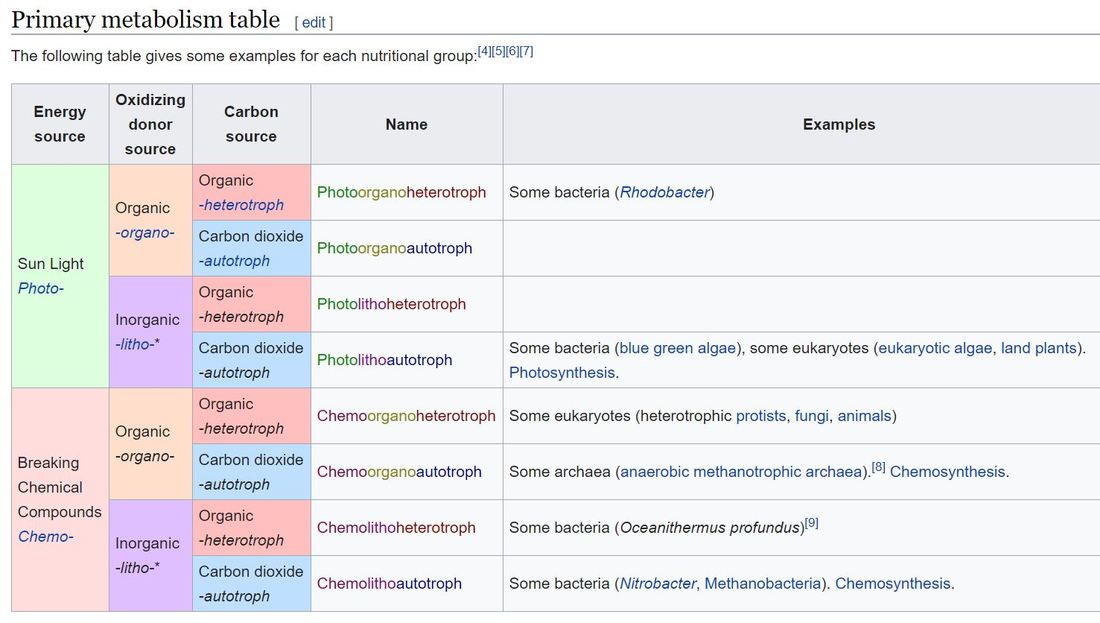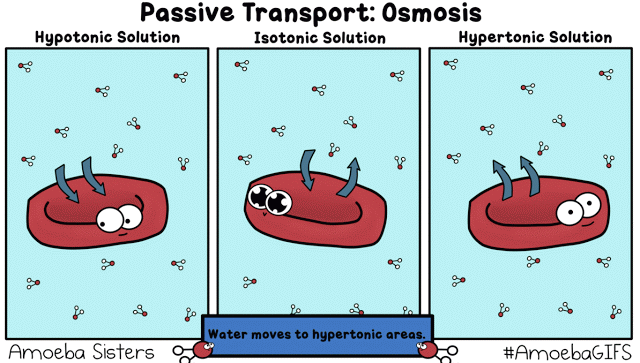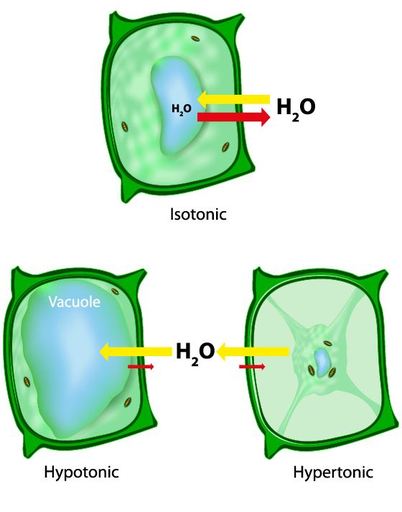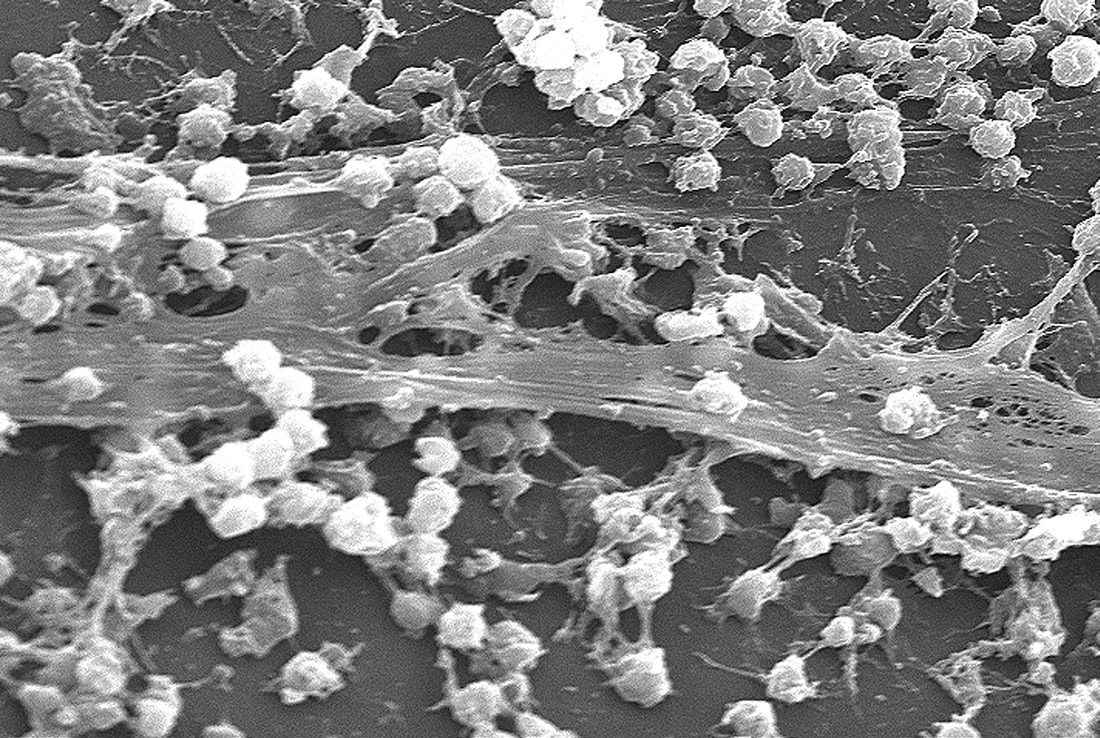Microbial Nutrition and Growth
The Grocery List
The nutritional needs of life.
Nutrients that are needed in relatively large amounts are categorized as macronutrients. Nutrients that are needed in small amount are considered micronutrients or trace elements. Macronutrients include nitrogen, oxygen, hydrogen, sulfur and phosphorus and are used as building blocks for the cell. Micronutrients are ionic forms the transition metals magnesium, potassium, sodium, calcium and iron. These ions are often used as cofactors or coenzymes within the cell and are needed in only very small quantities.
Nutrients that are needed in relatively large amounts are categorized as macronutrients. Nutrients that are needed in small amount are considered micronutrients or trace elements. Macronutrients include nitrogen, oxygen, hydrogen, sulfur and phosphorus and are used as building blocks for the cell. Micronutrients are ionic forms the transition metals magnesium, potassium, sodium, calcium and iron. These ions are often used as cofactors or coenzymes within the cell and are needed in only very small quantities.
Carbon-Based Life Forms
Despite the nutritional needs of organisms being very similar to one another, there is a lot of diversity in the way in which those nutrients are acquired. You have probably heard the term "carbon-based life forms". Carbon is the most abundant element found in all life forms as we now know it. Carbon is the central element for life. All organisms require a source of carbon. That carbon may come from an organic source, such as glucose, or an inorganic source, like sunlight or sulfur. Some organisms are able to obtain the carbon they need from carbon dioxide (CO2) in the air. Organisms that obtain carbon from an inorganic source, must process the carbon in order to get the carbon into a biologically useful form. On the other hand, organisms that that obtain their carbon from an organic source (food) are getting their carbon in a pre-packaged, ready-made form.
Hydrogen
Hydrogen is needed by the cells as a key component of macromolecules. Hydrogen functions in the transfer of energy. Hydrogen is simply 1 electron and 1 proton. Hydrogen can donate its electron becoming a hydrogen ion. The hydrogen ion is simply a proton, which has a +1 charge. In autotrophs hydrogen is required for oxidation-reduction Organisms must obtain energy, or hydrogen, from the environment.

Oxygen
Oxygen is of not a requirement for all organisms. In fact, in
its molecular form (O2), it can be toxic to some forms of microorganisms. Organisms that do require oxygen obtain it from the air or from water.
its molecular form (O2), it can be toxic to some forms of microorganisms. Organisms that do require oxygen obtain it from the air or from water.
Nitrogen
Many macromolecules contain nitrogen, including proteins, ATP and the nitrogenous bases on DNA and RNA. Some microorganisms are able to undergo nitrogen fixation. which allows them to obtain nitrogen from N2 gas in the atmosphere. Other obtain nitrogen through processing nitrates or even ammonia and urea.
Sulfur
Sulfur is used by organisms for protein synthesis, cellular respiration and photosynthesis. Organisms obtain it from the from sufur-containing amino acids methionine and cysteine as well as sulphates and sulphides.
Phosphorus
Phosphorus is needed in cells for the production nucleic acids and phospholipids, as well as other molecules such as ATP.
Growth Requirements
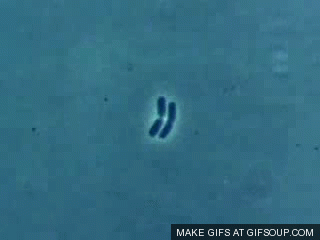
Microbiologists use the term growth to indicate an increase in a population of microbes rather than an increase in size. One of the reasons prokaryotic organisms, like bacteria, have been so successful for billions of years, is that they reproduce very quickly using a process called binary fission. Binary fission creates two genetically identical daughter cells from one single parent cell. This process is more simple than mitosis, which occurs in eukaryotic cells, and it requires less energy.
|
Growth, in terms of microbiology, refers to the number of individual organisms that make up a population of microbes. For example, when bacteria cells are allowed to grow on an agar plate, one single bacterial cell will reproduce via binary fission and give rise to a colony or genetically identical bacteria cells that were all generated from a single parent cell.
The photo is of individual colonies of E. Coli cells grown on an agar plate. |
Microbes must have the ability and the opportunity to metabolize the necessary nutrients they need for growth, survival, and reproduction. The nutrients needed vary greatly among different microbes. All living organisms are made up almost entirely (96 - 98 %) of only 4 common elements; carbon, oxygen, nitrogen and hydrogen. For this reason, the most important elements needed for microbial growth are
- Carbon
- Oxygen
- Nitrogen
- Hydrogen
All cells require three things to conduct metabolism: a carbon source, a source of energy, and a source of electrons or hydrogen atoms. Different organisms are able to use different compounds as their source of carbon.
There are 4 classes of organisms based on what they use as a source of carbon and what they can metabolize for energy.
There are 4 classes of organisms based on what they use as a source of carbon and what they can metabolize for energy.
- Photoautotrophs -
- Carbon Source - Photoautotrophs use carbon dioxide as a carbon source
- Energy Source - Photoautotrophs use light energy from the sun to make their own food.
- Chcmoautotrophs -
- Carbon Source - Chemoautotrophs use carbon dioxide as a carbon source
- Energy Source - Chemoautotrophs catabolize (break down) organic molecules (lipids, carbohydrates and proteins) for energy.
- Photoheterotrophs -
- Carbon Source - Photoheterotrophs catabolize organic molecules as a source of carbon.
- Energy Source - Photoheterotrophs use light from the sun as an energy source ehich they use to undergo photosynthesis.
- Chemoheterotrophs -
- Carbon Source - Chemoheterotrophs use organic compounds as a source of carbon
- Energy Source - Chemoheterotrophs use organic compounds as a source of energy, as well.
ENERGY SOURCE
The terms "photo-" and "chemo-" refer specifically to the energy source the organism will use. A phototrophic organism will obtain energy from sunlight, whereas a chemotrophic organism will obtain energy from organic molecules (proteins, lipids and carbohydrates).
ELECTRON SOURCE
Electron donors must be taken up from the environment. The steps of metabolism are redox reactions (oxidation/reduction reactions) which require an electron donor. Without an electron donor, metabolism will not occur.
The terms "organo-" and lith-" refer specifically to what molecule the organism uses as the electron donor in its metabolic processes. An organotroph will require organic compounds (proteins, lipids or carbohydrates) to be used as the electron donor in the metabolic chemical reactions. Lithotrophs require inorganic molecules to serve as electron donors in their metabolic processes, For example, plants will use the inorganic compound, water, as the electron donor in photosynthesis. Other lithotrophic organisms can use nitrates, nitrites, sulfur, hydrogen, and more! So, we can also classify organisms based on how they acquire the electrons they need for their metabolic processes. These classes include:
The terms "organo-" and lith-" refer specifically to what molecule the organism uses as the electron donor in its metabolic processes. An organotroph will require organic compounds (proteins, lipids or carbohydrates) to be used as the electron donor in the metabolic chemical reactions. Lithotrophs require inorganic molecules to serve as electron donors in their metabolic processes, For example, plants will use the inorganic compound, water, as the electron donor in photosynthesis. Other lithotrophic organisms can use nitrates, nitrites, sulfur, hydrogen, and more! So, we can also classify organisms based on how they acquire the electrons they need for their metabolic processes. These classes include:
- Organotrophs - Acquire electrons from organic sources (proteins, carbohydrates and lipids).
- Lithotrophs - Acquire electrons from inorganic sources (water, nitrates, nitrites, iron, sulfur, hydrogen, etc.)
CARBON SOURCE
The terms "auto-" and hetero-" refer specifically to what substance or molecule the organism will use as a source of carbon. Autotrophic organisms will use the inorganic compound, carbon-dioxide, as their source of carbon. Heterotrophic organisms will use organic compounds (proteins, lipids and carbohydrates) as their carbon source.

We can also classify organisms based on their need for oxygen. These classes include:
- Obligate Aerobes - Obligate Aerobes use oxygen as the final electron acceptor in the electron transport chain.
- Obligate Anaerobes - Obligate Anaerobes use another inorganic compound (other than oxygen) as the final electron acceptor in the terminate step of the electron transport chain. Some species of obligate anaerobes cannot tolerate oxygen and will die if exposed to oxygen.
- Facultative Anaerobes - Facultative anaerobes are able to use one set of metabolic processes when oxygen is present, and another one when oxygen supply is lacking. However, these organisms will undergo aerobic respiration if oxygen is present, because it generates a lot more ATP than anaerobic metabolic pathways.
- Aerotolerant Anaerobes - Aerotolerant anaerobic prefer to live in the absence of oxygen, but can tolerate being in the presence of oxygen without dying. These organisms are able to tolerate oxygen, because they contain vital enzymes that detoxify dangerous oxygen-containing compounds that would have otherwise had toxic effects in the cell.
- Microaerophiles - Microaerophiles are microbes that require low levels of oxygen to thrive.
- Capnophiles - Capnophiles require low levels of oxygen and high levels of carbon dioxide to grow.

Four forms of oxygen are toxic:
- Singlet Oxygen (O2) - A singlet oxygen is molecular oxygen that contains high energy electrons. These high energy molecules can be generated during the process of aerobic cellular respiration. These high energy electrons are very reactive and can lead to unwanted chemical reactions within the cell. Phototropic microorganisms have specialized pigments, called carotenoids, that are able to detoxify singlet oxygens by removing the excess energy from the electrons.
- Superoxide Radicals (02-) - Superoxide radicals can be formed when an oxygen molecule at the end of the electron transport chain undergoes incomplete reduction. Under normal circumstances, the oxygen molecules at the end of the electron transport chain receive 2 electrons from the electron transport chain, and 2 protons from the proton pump. This results in oxygen becoming water (H2O). Another source of superoxide radicals is when anaerobic organisms undergo their metabolic process in the presence of oxygen. Superoxide radicals can be detoxified by with the enzyme superoxude dismutase.
- Peroxide Anion (02 2-) - Peroxide anion can be formed during certain reactions catalyzed by the enzyme, superoxide dismutase. Two other enzymes, catalase and peroxidase, are able to detoxify the peroxide anion.
- Hydroxyl Radicals (OH) - Hydroxyl radicals are the neutral form of the hydroxide ion. These can be produced from ionizing radiation or when incomplete reduction of hydrogen peroxide occurs. Hydroxyl radicals are extremely reactive. Aerobic cells are protected from hydroxyl radicals, because their metabolic pathways do not use hydrogen peroxide.
Nitrogen Requirements
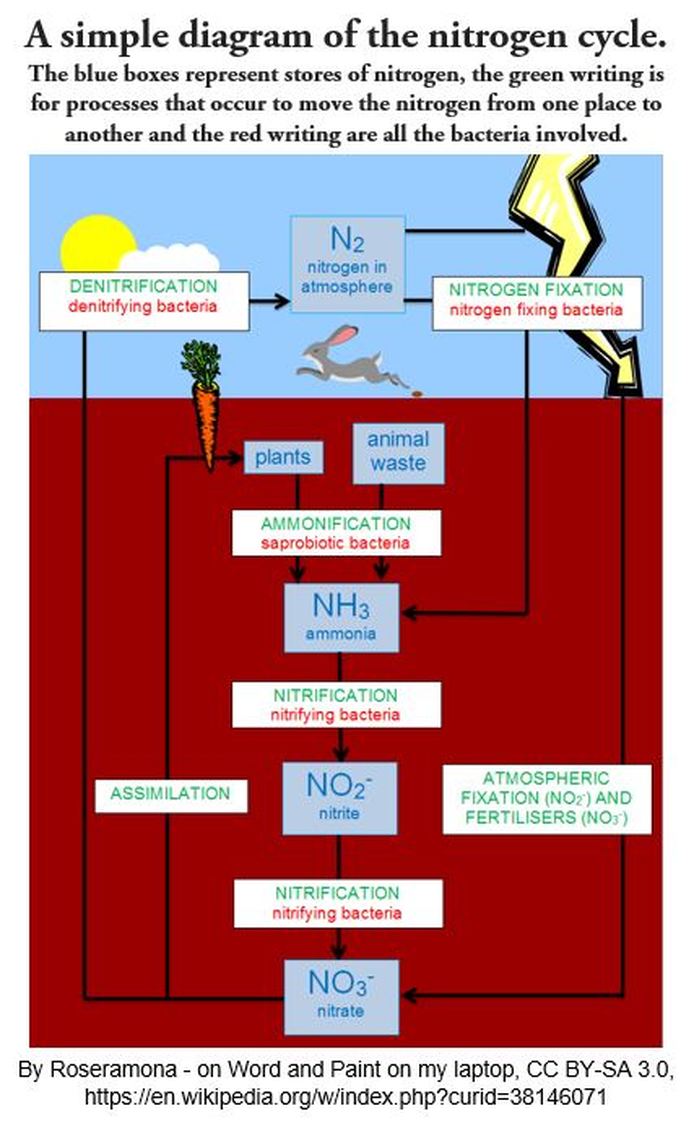
Our Earth's atmosphere contains about 79% nitrogen (N2). Many microorganisms require nitrogen to live. However, very few organisms are able to utilize the nitrogen gas provided so abundantly by the atmosphere. Most microbes acquire nitrogen from organic or inorganic resources. There are small number of bacteria that carry out the vital function of nitrogen fixation. Nitrogen fixation is a process in which these specialized bacteria are able to convert nitrogen gas from the atmosphere into ammonia which is more readily used by organisms.
Other Chemical Requirements

While carbon, nitrogen, oxygen and hydrogen remain, by far, the most abundant elements in microorganisms, there are also some trace elements that make up a small amount of these tiny lifeforms. Examples of these trace elements include selenium and zinc.
Microorganisms also require growth factors. Growth factors are organic compounds that are required for life, but cannot be synthesized within the cell. This is somewhat similar to the "essential amino acids" that humans must consume in their diet to stay healthy. Humans must obtain essential amino acids from the foods they eat, because they are needed by the body, but the body is unable to synthesize these amino acids from other building blocks.
Some vitamins can be used as growth factors for microbes.
Microorganisms also require growth factors. Growth factors are organic compounds that are required for life, but cannot be synthesized within the cell. This is somewhat similar to the "essential amino acids" that humans must consume in their diet to stay healthy. Humans must obtain essential amino acids from the foods they eat, because they are needed by the body, but the body is unable to synthesize these amino acids from other building blocks.
Some vitamins can be used as growth factors for microbes.
Physical Requirements

Microorganisms also require certain physical conditions in order to live and grow. These physical requirements include temperature, pH, osmolarity and pressure.
- Temperature - Different microbes have different temperature tolerances and requirements. Microbes will be able to grow, at least to some extent, when the temperature in within a certain range. However, microbes do have an optimal temperature that allows them to grow (reproduce) more rapidly. This temperature is known at the "optimum growth temperature". Microbes can be categorized according to their needs and tolerances of different temoeratures.
- Psychrophiles require temperatures below 20°C.
- Mesophiles grow best at temperatures ranging between about 20°C and 40°C.
- Thermophiles require temperatures above 45°C.
- Hyperthermophiles require temperatures above 80°C. pH
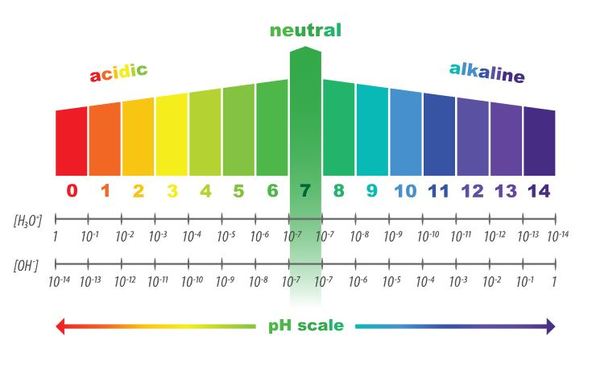
- pH - pH is the amount of hydrogen ions (protons or H+) or hydroxyl ions (OH-) that are free in a solution. The reason we refer to the acidity or basicity (alkalinity) of a solution as a "pH value", is because pH is the value of the "potential of hydrogen" The value of pH is calculated as the negative log of the molar concentration of hydrogen ions in solution. Living organisms are sensitive to pH, because the amount of hydrogen ions or hydroxyl ions will interfere with the normal chemical reactions (especially hydrogen bonding) in the cell. Microbes can be categorized according to their preference and tolerance of pH.
- Neutrophiles - Neutrophiles grow best when the pH is close to neutral, 7.0.
- Acidophiles - Acidophiles grow best in acidic environments with a pH as low as 0.0.
- Alkalinophiles - Alkalinophiles grow best in alkaline environments with a pH as high as 11.5.
Physical Effects of Water
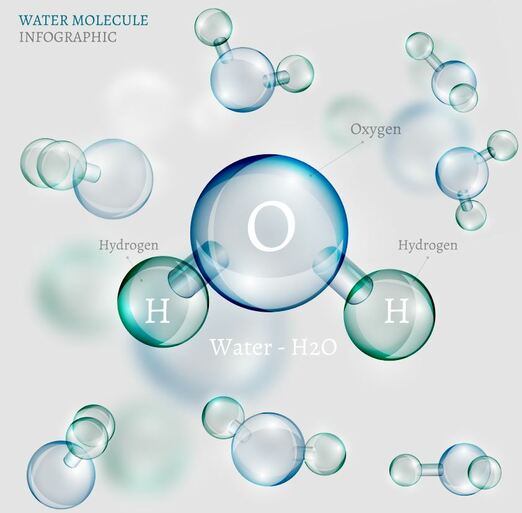
Water is necessary to sustain life. Water is known as "the universal solvent", because it is able to dissolve more substances than any other solvent known. Microorganisms need water to dissolve substances in the cell and to participate in metabolic processes. enzymes and nutrients and to act as a reactant in many metabolic reactions.
In nature, substances (including water) will diffuse from areas of high concentration to areas of low concentration. Cells are surrounded by a semipermeable plasma membrane that only allows certain solutes to travel across. This selective permeability will create osmotic pressure due to the amount of dissolved substances (solutes) in the extracellular fluid versus the intracellular fluid.
In nature, substances (including water) will diffuse from areas of high concentration to areas of low concentration. Cells are surrounded by a semipermeable plasma membrane that only allows certain solutes to travel across. This selective permeability will create osmotic pressure due to the amount of dissolved substances (solutes) in the extracellular fluid versus the intracellular fluid.
|
Different microorganisms have different preferences and requirements of osmotic pressure. Microbes that do not have a cell wall can experience a phenomenon known as osmotic shock. Osmotic shock occurs when a microbe that lacks a cell wall is placed into an environment that has an osmotic pressure that it cannot tolerate. When the there are more dissolved substances in the surrounding fluid than there are inside of the microorganism, we call this a hypertonic environment. In a hypertonic environment, water molecules will diffuse out of the microoorganism, causing the microbe to undergo crenation (shrinking) which leads to death. When the surrounding environment contains fewer dissolved substances than there are inside the microbe, this is considered as hypotonic environment. In a hypotonic environment, there will be a driving force on water that drives the water molecules to travel into the microbe. This results in swelling or even bursting which leads to death.
Microorganisms that have a cell are more resistant against osmotic pressure, yet they can still experience osmotic stress under certain conditions. We can classify microbe based on their preferences, tolerances and requirements for osmotic pressure. |
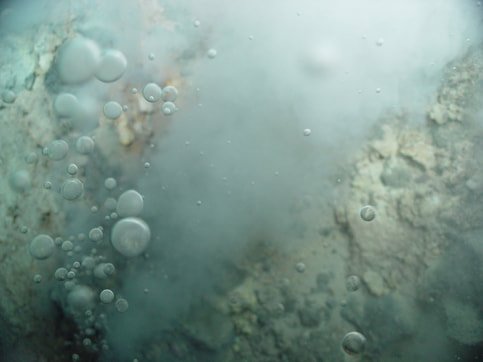
- Obligate Halophiles - require the high osmotic pressure such as the osmotic pressure provided by salt water.
- Facultative Halophiles - do not require high osmotic pressure, but they are able to tolerate the high osmotic pressure created by salt water.
Osmotic pressure is not the only type of pressure that water is able to exert on microorganisms. As anyone who has ever dove into the deep end of a pool knows, the deeper the water is, the more pressure is exerted on the organism. The pressure that exists in the deep ocean creates an environment that few organisms can survive. The organisms that make these depths their home, swell or literally explode as they are brought to the ocean's surface due to the lack of pressure.
- Barophiles - are specially adapted to live in high pressure environments. The physical structure of their membranes, as well as the proteins and enzymes the barophile needs for life, will require high pressure in order to maintain their shape.
Ecological AssociationsBiofilm - Biofilms are created by the symbiosis of 2 different microbial species growing together. The microorganisms that make up the biofilm stick to each other and adhere to some sort of physical surface. These cells will then secrete slime which coats the biofilm in a protective sticky, slimy film.
|
Culturing Microorganisms
Microbiologists collect a small sample of microbes from a given source (we call this small sample an "inoculum") and place them into a medium that contains the nutrients needed for growth. This creates a cell culture. The medium can be in a liquid form (called broth) or in a somewhat solid, gelatin-like form (called agar/agarose).
Microbial growth using an agar plate will yield individual colonies of cells that have been derived from a single parent cell. This method is used in clinical laboratories to test samples of feces, saliva, cerebrospinal fluid, or blood for the presence of microorganisms.
Microbial growth using an agar plate will yield individual colonies of cells that have been derived from a single parent cell. This method is used in clinical laboratories to test samples of feces, saliva, cerebrospinal fluid, or blood for the presence of microorganisms.
Obtaining Pure Cultures
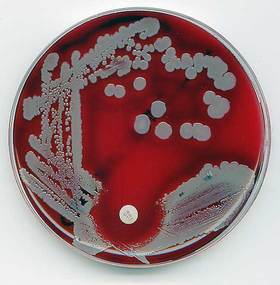
Microorganisms are everywhere; on our skin, on surfaces and in the air. Because this is the case, it is important to protect cell cultures from contamination Microbiologists are usually intending to grow axenic cultures. An axenic culture will consist of a colony of cells generated from a single parent cell (progenitor cell) or colony-forming unit (CFU). In order to produce such a cell culture, efforts must be taken to sterilize any substance, media, loops, glassware, etc. that may come into contact with the culture. Sterile techniques have been developed to reduce the risk of contamination. Here are some of the more popular sterile techniques used today.
- The Streak Plate Method. In this technique, a sterile inoculating loop is used to spread an inoculum across the surface of the agar in a Petri dish. The dish or plate will develop colonies following a time of incubation.
- The Pour Plate Technique - In this technique, colonies are isolated through a series of serial dilutions. The final dilution is then added to warm agar in a Petri dish. The dish will produce colonies after an incubation period.
Culture Media
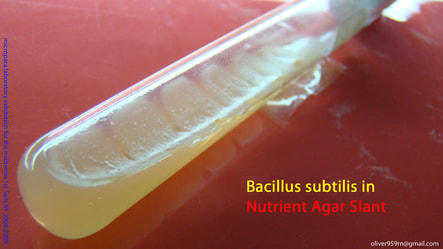
- Agar - Agar is the most widely used culture media. It consists of a complex polysaccharide that has a low melting point and is easy to work with. Warm agar can be pour into Petri dishes to form Petri plates, or poured into test tubes that will be kept slanted until the agar solidifies to become slant tubes (or slants).
- Synthetic Media - Synthetic media is made in a wide variety of forms that adds growth factors and specific nutrients which can be used for a greater variety of microorganisms. In addition, synthetic media can be altered to select for the growth of only specific types of microbes.
- Differential Media - Differential media is manufactured to undergo visible changes depending on the types of colonies produced. This media assists the microbiologist in identifying more than one microbial species which may be present in a sample.
- Reducing Media - A reducing medium is used when culturing anaerobes, because it contains compounds that remove free oxygen from the solution.
- Transport Media - Transport media contains chemicals that act to prevent contamination from the environment.
Special Culture Techniques
- Low-Oxygen Cultures - Low-oxygen cultures are required for growing microorganisms that thrive in low-oxygen environments.
- Oxygen-Free Cultures - Carbon dioxide incubators are used to remove oxygen from cultures of anaerobic microbes.
- Enrichment Cultures - A selective media is used that only allows the growth of specific microbes.
- Cold-Enrichment Cultures - Microbes that thrive in cold environments must be grown in a culture that is kept cold by refrigeration.
Preserving Cultures
- Refrigeration (4°C) - This cold temperature will slow the growth of most microbial species without causing death. This is good for short-term storage (3-7 days).
- Deep-Freezing (-50°C to -95°C) - long-term storage requires colder temperatures of between -50 and -95 degrees Celsius.
- Lyophilization - This process "freeze dries" the cell culture. The culture is first frozen, then the water content of the culture is removed using vacuum. This is a good technique for log-term storage.
Growth of Microbial Populations
Microorganisms reproduce rapidly using binary fission. Microbes will reproduce exponentially as long as they have the needed nutrients and space and have a habitat free of toxins. This means that a single microorganism can quickly generate a population of cells that are astronomical in number!
- Generation Time - This is the time required for a population of cells to double in size. Most bacteria have a generation time of 1-3 hours.
Phases of Microbial Growth
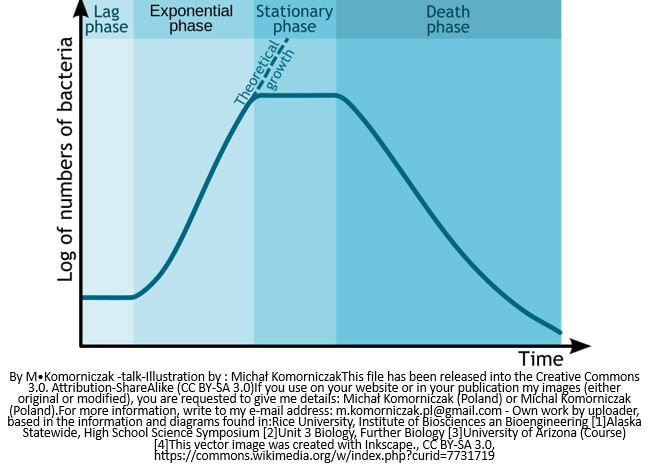
When we analyze bacterial growth, it is convenient to create a graph of the number of bacteria versus time. This type of graph is called a "growth curve". Analyzing these growth curves reveals distinct phases of bacterial growth.
- The Lag Phase - The lag phase of the growth curve is generated from the bacteria adjusting to their new environment. The cells will not undergo binary fission until they have adapted to the new habitat.
- The Log Phase - The log phase of the growth curve reveals the active growth of bacteria in the population.
- The Stationary Phase - When the population of bacteria begins to run out of space and nutrients and/or when toxins are built up in the culture, the log phase will give way to the stationary phase. In the stationary phase, the number of bacteria cells in the population will remain fairly consistent due to the fact that the number of cells being created will be roughly equal to the number of cells dying.
- The Death Phase - After some time, the depletion of nutrition and space and the buildup of toxins in the culture, will cause more cells to be dying than cell being produced. This is the death phase of the growth curve.
So, how do we determine the numbers of individual cells in a culture or colony?
- Counting Colonies - Count individual colonies that are formed when plated.
- Membrane Filtration - The culture is filtered through a membrane filter then counted using a cell counter slide that contains an etched grid. The total number of cells is estimated from taking the mean average of several counted squares on the grid.
- Electronic Cell Counters - These devices count cells by determining how electrons from an electron beam going through a sample are blocked.
- The Most-Probable Number (MPN) Method - This is a statistical estimating technique based on the fact that the more bacteria in a sample, the more dilutions are required to reduce their number to zero.
- Turbidity - Determination of how "cloudy" a sample is using spectrophotometry.

